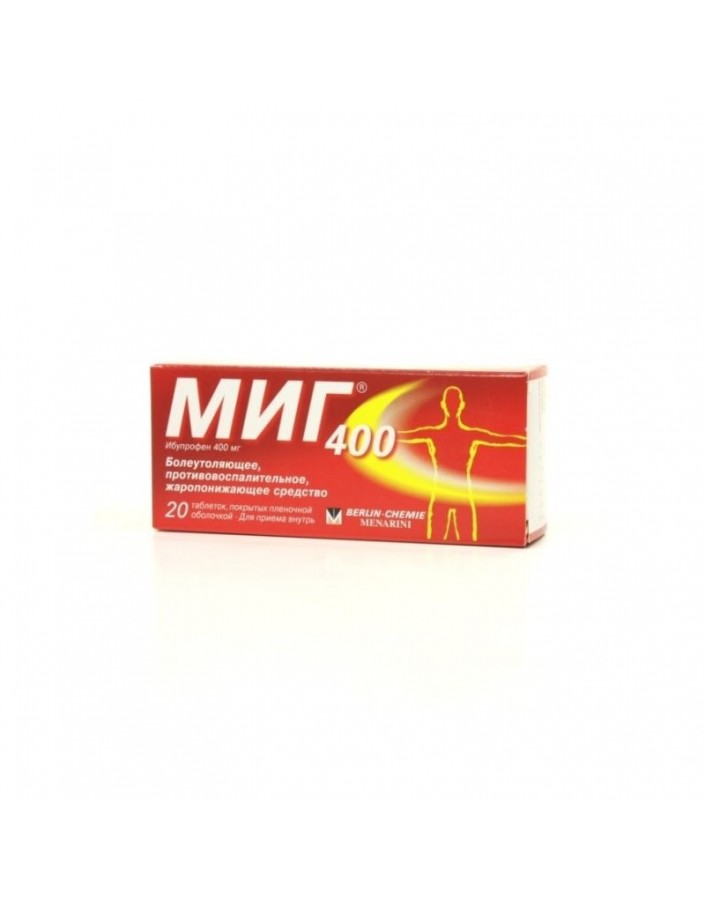




Security policy (edit with Customer reassurance module)

Delivery policy (edit with Customer reassurance module)

Return policy (edit with Customer reassurance module)
Composition and release form
Coated tablets:
1 pill contains Ibuprofen 400 mg;
excipients: corn starch, sodium carboxymethyl starch type A, highly dispersed silicon dioxide, Magnesium stearate.;
in the package 20 pcs.
pharmachologic effect
MIG 400 is a nonsteroidal anti-inflammatory drug (NSAIDs). Ibuprofen is a derivative of propionic acid and has analgesic, antipyretic and anti-inflammatory effects due to non-selective blockade of COX-1 and COX-2, as well as an inhibitory effect on the synthesis of prostaglandins.
The analgesic effect is most pronounced for inflammatory pain. Analgesic activity of the drug is not a narcotic type.
Like other NSAIDs, ibuprofen has antiplatelet activity.
Indications
Headache, migraine, toothache, neuralgia, pain in muscles and joints, menstrual pain, fever with colds and flu.
Contraindications
Hypersensitivity to the drug;
Hypersensitivity to Acetylsalicylic acid or other NSAIDs in history.
Erosive and ulcerative diseases of the gastrointestinal tract (including gastric ulcer and duodenal ulcer in the acute stage, Crohn's disease, ulcerative colitis).
"Aspirin" asthma.
Hemophilia and other bleeding disorders (including hypocoagulation), hemorrhagic diathesis.
Bleeding of any etiology.
Deficiency of glucose-6-phosphate dehydrogenase.
Pregnancy. and lactation period.
Children's age up to 12 years.
Diseases of the optic nerve.
With care: advanced age; heart failure; arterial hypertension; cirrhosis of the liver with portal hypertension; hepatic and / or renal failure, nephrotic syndrome, hyperbilirubinemia; peptic ulcer of the stomach and duodenum (in history), gastritis, enteritis, colitis; blood diseases of unknown etiology (leukopenia and anemia).
Dosage and administration
MiG 400 is taken orally. Dosing regimen set individually depending on the evidence.
Adults and children over 12 years old are prescribed, as a rule, in the initial dose - 200 mg 3-4 times / day. To achieve a rapid therapeutic effect, the dose can be increased to 400 mg 3 times / day. Upon reaching the therapeutic effect, the daily dose is reduced to 600-800 mg.
The drug MIG 400 should not be taken for more than 7 days or in higher doses. If necessary, use longer or in higher doses, you should consult a doctor.
In patients with impaired renal function, liver or heart, the dose should be reduced.
Side effects
On the part of the digestive system: NPVS-gastropathy - abdominal pain, nausea, vomiting, heartburn, loss of appetite, diarrhea, flatulence,constipation; rarely, ulceration of the gastrointestinal tract mucosa, which in some cases is complicated by perforation and bleeding; possible irritation or dryness of the oral mucosa, pain in the mouth, ulceration of the mucous membrane of the gums, aphthous stomatitis, pancreatitis, hepatitis.
On the part of the respiratory system: shortness of breath, bronchospasm.
On the part of the senses: hearing loss, ringing or tinnitus, toxic lesion of the optic nerve, blurred vision or double vision, scotoma, dryness and eye irritation, conjunctival edema and eyelid (allergic origin).
On the part of the central nervous system and peripheral nervous system: headache, dizziness, insomnia, anxiety, nervousness and irritability, psychomotor agitation, drowsiness, depression, confusion, hallucinations, rarely - aseptic meningitis (often in patients with autoimmune diseases).
Cardiovascular: heart failure, tachycardia, increased blood pressure.
On the part of the urinary system: acute renal failure, allergic nephritis, nephrotic syndrome (edema), polyuria, cystitis.
Allergic reactions: skin rash (usually erythematous or urtikarnaya), pruritus, angioedema, anaphylactoid reactions, anaphylactic shock, bronchospasm or dyspnea, fever, erythema multiforme (including erythema syndrome (including SJS syndrome, imitations), multiforme exudative erythema (including SJ syndrome, imitation, fever, multiforme exudative erythema and including erythema and dyspnea, anaphylactic shock, bronchospasm or dyspnea, fever, erythema multiforme erythema (including SJ syndrome, fever, erythema and erythema) Lyell), eosinophilia, allergic rhinitis.
From the hemopoietic system: anemia (including hemolytic, aplastic), thrombocytopenia and thrombocytopenic purpura, agranulocytosis, leukopenia.
On the part of laboratory parameters: it is possible to increase bleeding time, decrease serum glucose concentration, decrease QC, decrease hematocrit or hemoglobin, increase serum creatinine concentration, increase the activity of hepatic transaminases.
With prolonged use of the drug in high doses increases the risk of ulceration of the gastrointestinal tract mucous membrane, bleeding (gastrointestinal, gingival, uterine, hemorrhoidal), visual impairment (color vision disorders, scotomas, damage to the optic nerve).
Storage conditions
In the dark place at a temperature of no higher than 20 ° C.
Shelf life - 3 years.